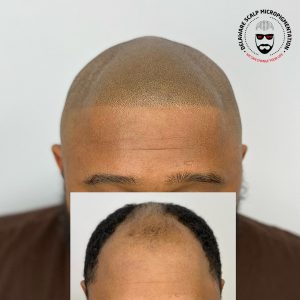Introduction
A well-defined and symmetrical hairline can significantly contribute to a person’s overall appearance and self-confidence. However, not everyone is blessed with a perfectly even hairline. An uneven hairline can result from various factors, including genetics, aging, medical conditions, or even hairstyling practices. In this comprehensive guide, we will explore the common causes of an uneven hairline and provide valuable insights into how you can fix it. Whether you’re dealing with a receding hairline, widow’s peak, or simply a misaligned hairline, this article aims to help you understand the root causes and discover effective solutions.

Understanding the Anatomy of the Hairline
Before delving into the causes and solutions for an uneven hairline, it’s essential to grasp the basics of hairline anatomy. The hairline is the border between the forehead and the scalp, where hair growth begins. It varies in shape and placement from person to person, creating the unique and individualized hairline patterns we observe.
There are several common types of hairlines, including straight, rounded, V-shaped, and widows’ peaks. These variations can affect the perception of hairline symmetry and can be influenced by genetics. Straight hairlines, for example, run parallel to the forehead, creating a clean and even look, while widows’ peaks have a distinctive V-shape at the center.
Understanding the hair growth cycle is crucial when addressing hairline issues. The cycle consists of anagen (growth), catagen (transition), and telogen (rest) phases, and it influences hair density and thickness. Hairline concerns can often be linked to disruptions in this cycle, such as prolonged periods of rest (telogen effluvium) leading to thinning.
Common Causes of an Uneven Hairline
An uneven hairline can be attributed to several factors, both genetic and environmental. Identifying the root cause is the first step toward finding an effective solution. Here are the most common causes:
Genetics
One of the primary factors contributing to an uneven hairline is genetics. Your family history plays a significant role in determining the shape, placement, and density of your hairline. If your parents or grandparents had an uneven hairline, you are more likely to inherit similar characteristics, making it a hereditary issue.
Aging
As we age, our hair naturally goes through changes, including thinning and receding. A receding hairline is a common sign of aging, and it can result in unevenness as the hairline gradually moves backward. Understanding the impact of aging on your hairline is crucial in addressing this concern.
Hormonal Changes
Hormonal fluctuations, such as those experienced during pregnancy, menopause, or certain medical conditions, can impact hair growth patterns, potentially leading to an uneven hairline. Hormonal imbalances should be considered if you notice sudden changes in your hairline, such as hair thinning during pregnancy.
Medical Conditions
Certain medical conditions, such as alopecia areata, thyroid disorders, and scalp infections, can cause hair loss and disrupt the natural hairline. Identifying and treating these underlying medical issues is essential for addressing an uneven hairline effectively. Alopecia areata, for example, is an autoimmune condition that causes hair loss in small, round patches, potentially affecting the hairline’s symmetry.
Trauma or Injury
Injuries to the scalp or forehead can damage hair follicles and alter the appearance of the hairline. Surgical procedures, like hair transplant surgeries, can also affect hairline symmetry. Recognizing past injuries or surgical interventions is important when assessing your hairline, as they may have a significant impact.
Evaluating Your Uneven Hairline
Before seeking a solution for your uneven hairline, it’s essential to assess its severity and type. This evaluation will help you determine the most appropriate course of action.
Hairline Symmetry
Take a close look at your hairline and identify any irregularities or asymmetry. Note whether it’s a receding hairline, a widows’ peak, or a different type of unevenness. Understanding the specific characteristics of your hairline will guide your choice of solutions. For instance, if you have a receding hairline, you may need a different approach than someone with a pronounced widows’ peak.
Hair Density
Check the density of hair along your hairline. Thinning or sparse areas may contribute to the uneven appearance. Identifying areas with lower hair density can help target treatments effectively. For individuals with thinning hairlines, solutions like topical treatments or hair transplants may be more suitable.
Solutions for an Uneven Hairline
Depending on the cause and severity of your uneven hairline, there are various solutions available to address the issue. Here are some options to consider:
Hairstyling Techniques
One of the simplest ways to conceal an uneven hairline is through strategic hairstyling. Experiment with different hairstyles, such as bangs or layers, to create the illusion of a balanced hairline. Consult with a professional hairstylist for personalized recommendations, as they can provide expert guidance on styles that suit your face shape and hair type. Styling products like hair gel or mousse can also help you achieve the desired look.
Hair Products and Treatments
Topical treatments like minoxidil can stimulate hair growth and improve hairline density. Consult with a dermatologist or trichologist to determine the best products for your specific needs. Understanding the potential benefits of these treatments is essential for effective results. Minoxidil, for instance, promotes hair growth by increasing blood flow to the hair follicles, but it may take several months to see noticeable improvements. Additionally, prescription medications like finasteride may be recommended to inhibit further hair loss by blocking the hormone dihydrotestosterone (DHT).
Hair Transplants
Hair transplant procedures, such as follicular unit transplantation (FUT) or follicular unit extraction (FUE), can restore hair to areas of an uneven hairline. These surgical options are effective for addressing receding or thinning hairlines. However, it’s essential to consider the associated costs, potential side effects, and recovery periods before opting for these procedures. Hair transplants involve removing hair follicles from one part of your body (usually the back or sides of your scalp) and implanting them in the areas with thinning or receding hair. While they offer long-lasting results, they are not without risks, such as scarring and infection.
Platelet-Rich Plasma (PRP) Therapy
PRP therapy involves injecting platelet-rich plasma from your blood into the scalp to stimulate hair follicle growth. It can be a non-surgical option for enhancing hairline density. Understanding the mechanism and potential benefits of PRP therapy is crucial before considering this treatment. PRP contains growth factors that can promote hair growth by nourishing hair follicles. The procedure typically involves multiple sessions, and results may vary from person to person. PRP can be used in conjunction with other treatments like minoxidil to enhance their effectiveness.
Scalp Micropigmentation (SMP)
Scalp micropigmentation is a non-invasive cosmetic procedure that has gained popularity as an effective solution for individuals with an uneven hairline. SMP involves the careful application of pigments to the scalp to create the appearance of tiny hair follicles. This technique can effectively mimic the look of a closely shaved head, making it a suitable option for those with receding hairlines, thinning hair, or pattern baldness. SMP is highly customizable, allowing individuals to achieve their desired hairline shape and density.
SMP is typically performed in multiple sessions, with each session lasting a few hours. During the procedure, a trained technician uses a specialized microneedling device to deposit pigment into the upper layer of the scalp. The technician carefully matches the pigment color to your existing hair color to achieve a natural appearance.
The results of SMP are immediate, and many individuals experience a significant improvement in the appearance of their hairline after the first session. However, multiple sessions may be required to achieve the desired level of density and coverage. SMP is a long-lasting solution, but it may require periodic touch-ups every few years to maintain its vibrancy and appearance.
Scalp micropigmentation offers several advantages, including:
– Natural Appearance: When performed by a skilled technician, SMP creates a remarkably natural-looking hairline that blends seamlessly with your existing hair.
– Low Maintenance: SMP requires minimal maintenance compared to other hair restoration options. You won’t need to worry about daily hair care routines or ongoing treatments.
– Quick Recovery: There is little to no downtime associated with SMP, and you can typically resume your regular activities shortly after each session.
– Versatility: SMP can be used to address various hairline concerns, from receding hairlines to pattern baldness. It’s suitable for both men and women.
Maintaining a Healthy Hairline
Regardless of the solution you choose, it’s crucial to maintain a healthy hairline to prevent further issues. Here are some tips for maintaining optimal hairline health:
Proper Nutrition
A balanced diet rich in vitamins and minerals, especially those promoting hair health (e.g., biotin, vitamin D, and iron), can support hair growth and overall hairline health. Understanding the role of nutrition in maintaining your hair’s vitality is essential. Include foods like eggs, nuts, leafy greens, and lean proteins in your diet to nourish your hair follicles.
Hair Care Practices
Avoid excessive heat styling, harsh chemicals, and tight hairstyles that can damage your hair and scalp. Gentle hair care practices can help maintain a healthy hairline. Consulting with a hair care expert for personalized advice is recommended. Choose shampoos and conditioners that suit your hair type and avoid over-washing, as it can strip your hair of natural oils.
Stress Management
Chronic stress can contribute to hair loss and thinning. Incorporate stress-reduction techniques like meditation and yoga into your routine to promote hairline health. Recognizing the impact of stress on your hair is crucial for prevention. Practicing relaxation techniques and finding healthy ways to manage stress can significantly benefit your hairline and overall well-being.
Regular Scalp Care
Keep your scalp clean and moisturized to support hair growth. A clean and healthy scalp is essential for maintaining an even hairline. Using suitable scalp care products and techniques can help maintain scalp health. Choose gentle, sulfate-free shampoos and conditioners, and consider using a scalp brush to exfoliate and improve circulation.
Conclusion
An uneven hairline can be a source of self-consciousness for many individuals, but it’s important to remember that there are numerous solutions available. Whether you opt for cosmetic camouflage, hair transplants, or simpler hairstyling techniques, finding the right solution for your unique situation is possible. Additionally, maintaining a healthy hairline through proper nutrition, stress management, and gentle hair care practices can help prevent further issues.
Ultimately, the key to addressing an uneven hairline is understanding its underlying cause and seeking guidance from professionals who can provide tailored solutions. By taking proactive steps and exploring the options outlined in this guide, you can achieve a more even and confident appearance.
